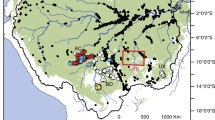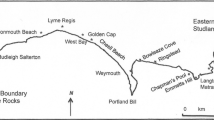Abstract
Clam gardens are ancient mariculture features developed by Indigenous Peoples of the Northwest Coast of North America that create shallow sloping intertidal shelves where clam productivity is enhanced. We quantify the area of clam habitat created by constructing rock-walled clam gardens terraces in northern Quadra Island, British Columbia, Canada. We combined modelling, high-resolution mapping, beach sampling, and a comprehensive survey of the shoreline to document the location and areal extent of clam habitat in clam gardens today. We divided our analysis into three classes of clam gardens, which differ in substrate and thus the amount of clam habitat created. We found that Indigenous People built clam garden walls on 35% of the shoreline and that about 112,979 m2 of flat beach terrace were created by clam garden construction. Collectively, the three classes of clam gardens increased clam habitat area between 26 and 36%. About 35% of the area of clam habitat in clam gardens was constructed de novo on bedrock shelves and rocky slopes where no clam habitat existed previously. Furthermore, about 12.0% of clam gardens are smaller than 30 m2, reflecting the effort put into creating enhanced food production wherever possible. Our analysis demonstrates that clam management in the form of clam gardens was extensive prior to colonization and that these features still have a significant impact on today’s intertidal ecosystems. Clam habitat expansion facilitated by clam garden construction encouraged a sustainable and abundant food source in the past and could do so again in today’s changing environmental conditions.






Similar content being viewed by others
References
Augustine S, Dearden P. 2014. Changing paradigms in marine and coastal conservation: A case study of clam gardens in the Southern Gulf Islands, Canada. The Canadian Geographer 58:305–14.
Ban NC, Frid A, Reid M, Edgar B, Shaw D, Siwallace P. 2018. Incorporate Indigenous perspectives for impactful research and effective management. Nature Ecology and Evolution 2:1680–3.
Berkes F. 2018. Sacred ecology. New York: Routledge. p 368p.
Chew, KK, Ma, AP. 1987. Species profiles: life histories and environmental requirements of coastal fishes and invertebrates (Pacific Northwest) – common littleneck clam. U.S. Fish Wildlife Service Biological Report 82(1.78). U.S. Army Corps of Engineers, TR EL-82-4. 22 pp.
Cox KD, Gerwing TG, Macdonald T, Hessing-Lewis M, Millard-Martin B, Command RJ, Juanes F, Dudas SE. 2019. Infaunal community responses to ancient clam gardens. ICES Journal of Marine Science . https://doi.org/10.1093/icesjms/fsz153.
Cronin W. 1996. The trouble with wilderness: Or, getting back to the wrong nature. Environmental History 1:7–28.
Crowell, TD. 2017. Refining local sea-levels through settlement change in Kanish and Waiatt Bays, Quadra Island. Unpublished Master’s thesis, Simon Fraser University, Burnaby, BC.
Day GM. 1953. The Indian as an ecological factor in the northeastern forest. Ecology 34:329–46.
Deur D, Turner NJ, Eds. 2005. Keeping it living: traditions of plant use and cultivation on the Northwest Coast of North America. Seattle, WA: University of Washington Press.
Deur D, Turner NJ, Dick A, Sewid-Smith D, Recalma-Clutesi K. 2013. Subsistence and resistance on the British Columbia coast: Kingcome village’s estuarine gardens as contested space. BC Studies 179:13–37.
Deur D, Dick A, Recalma-Clutesi K, Turner NJ. 2015. Kwakwaka’wakw “clam gardens”: motive and agency in traditional Northwest Coast mariculture. Human Ecology 43:201–12.
Fedje D, McLaren D, James TS, Mackie Q, Smith NF, Southon JR, Mackie AP. 2018. A revised sea level history for the northern Strait of Georgia, British Columbia, Canada. Quaternary Science Review 192:300–16.
Fowler CS, Lepofsky D. 2011. Traditional Resource and Environmental Management. In: Anderson EN, Pearsall D, Hunn E, Turner NJ, Eds. Ethnobiology. Wiley-Blackwell: Hoboken, NJ. p 285–304.
Fisher JA, Shackelford N, Hocking MD, Trant AJ, Starzomski BM. 2019. Indigenous peoples’ habitation history drives present-day forest biodiversity in British Columbia’s coastal temperate rainforest. People and Nature 1:103–14.
Groesbeck A, Rowell K, Lepofsky D, Salomon AK. 2014. Ancient clam gardens increased production: adaptive strategies from the past can inform food security today. PloS ONE 9(3). https://doi.org/10.1371/journal.pone.0091235
Harris C. 1994. Voices of disaster: Smallpox around the Strait of Georgia in 1782. Ethnohistory 41:591–626.
Hunn ES, Johnson DR, Russell PN, Thornton TF. 2003. Huna Tlingit traditional environmental knowledge, conservation, and the management of a “wilderness” park. Current Anthropology 44(S5):S79–103.
Jackley J, Gardner L., Djunaedi AF, Salomon AK. 2016. Ancient clam gardens, traditional management portfolios, and the resilience of coupled human- ocean systems. Ecology and Society 21(4). https://doi.org/10.5751/ES-08747-210420
Joseph, L. 2012. Finding our roots: Ethnoecological restoration of lhasem (Fritillaria camschatcensis (L.) Ker-Gawl), an iconic plant food in the Squamish River Estuary, British Columbia. Unpublished master’s thesis, University of Victoria, Victoria, British Columbia.
Joyce AL, Canessa R. 2009. Spatial and temporal changes in access rights to shellfish. Resources in British Columbia. Coastal Management 37:585–616.
Joyce AL, Satterfield T. 2010. Shellfish aquaculture and First Nations’ sovereignty: The quest for sustainable development in contested sea space. Natural Resources Forum 34:106–23.
Lepofsky D, Armstrong CG, Jackley J, Greening S, Carpenter J, Guernsey B, Mathews D, Turner NJ. 2017. Historical ecology of cultural keystone places of the Northwest Coast. American Anthropologist 11:395–575.
Lepofsky D, Caldwell ME. 2013. Indigenous marine resource management on the Northwest Coast of North America. Ecological Processes 2:1–12.
Lepofsky D, Kahn J. 2011. Cultivating an ecological and social balance: elite demands and commoner knowledge in ancient Maohi agriculture, Society Islands. American Anthropologist 113:319–35.
Lepofsky D, Smith NF, Cardinal N, Harper JR, Morris MC, Gitla E, Bouchard R, Kennedy DID, Salomon AK, Puckett M, Rowell K, McLay E. 2015. Ancient shellfish mariculture on the Northwest Coast of North America. American Antiquity 80:236–59.
Lertzman K. 2009. The paradigm of management, management Systems, and resource stewardship. Journal of Ethnobiology 29:339–58.
Londoño AC, Williams PR, Hart ML. 2017. A change in landscape: Lessons learned from abandonment of ancient Wari agricultural terraces in Southern Peru. Journal of Environmental Management 202:532–42.
Neudorf CM, Smith NF, Lepofsky D, Toniello G, Lian OB. 2017. Between a rock and a soft place: using optical ages to date ancient clam gardens on the Pacific Northwest. PLoS ONE 12(2). https://doi.org/10.1371/journal.pone.0171775
Moss ML. 1993. Shellfish, gender, and status on the Northwest Coast of North America: reconciling archaeological, ethnographic, and ethnohistorical records of the Tlingit. American Anthropologist 93:631–52.
Moss ML, Wellman HP. 2017. The Magoun clam garden near Sitka, Alaska: Niche construction theory meets traditional ecological knowledge, but what about the risks of shellfish toxicity? Alaska Journal of Anthropology 15:7–24.
Odonne G, van den Bel M, Burst M, Brunaux O, Bruno M, Dambrine E, Davy D, Desprez M, Engel J, Ferry B, Freycon V, Grenand P, Jérémie S, Mestre M, Molino J-F, Petronelli P, Sabatier D, Hérault B. 2019. Long-term influence of early human occupations on current forests of the Guiana Shield. Ecology 100(10):e02806. https://doi.org/10.1002/ecy.2806.
Quayle DB, Bourne N. 1972. The Clam Fisheries of British Columbia. Ottawa, Canada: Fisheries Research Board of Canada.
Ross NJ. 2011. Modern tree species composition reflects ancient Maya “forest gardens” in Northwest Belize. Ecological Applications 21:75–84.
Salomon AK, Lertzman K, Brown K, Wilson B Kii’iljuus, Secord D. McKechnie I. 2018. Democratizing conservation science and practice. Ecology and Society 23, 1: 44. https://www.ecologyandsociety.org/ vol23/iss1/art44/
Salter, N. 2018. Ancient clam gardens magnify bivalve production by moderating ambient temperature and enhancing sediment carbonate. Unpublished master’s thesis, Simon Fraser University, Burnaby, BC.
Schoon M, Van der Leeuw S. 2015. The shift toward social-ecological systems perspectives: insights into the human-nature relationship. Natures Sciences Sociétés. 23 (2). https://doi.org/10.1051/nss/2015034
Senos R, Lake FK, Turner NJ, Martinezs D. 2006. Traditional ecological knowledge and restoration practice. In: Apostol D, Sinclair M, Eds. Restoring the Pacific Northwest: The Art and Science of Ecological Restoration in Cascadia. Washington: Island Press. p 393–426.
Silver JJ. 2014. Shellfish and coastal change: Pacific oysters and manila clams in BC waters. BC Studies 181:83–103.
Smith NF, Lepofsky D, Toniello G, Neudorf CM, Wilson L, Roberts C. 2019. Dating clam gardens on the Northwest Coast of North America. PLoS ONE . https://doi.org/10.1371/journal.pone.0211194.
Taylor J. 2009. The Quadra Story: A History of Quadra Island. Madeira Park: Harbour Publishing Co., Ltd.
Toniello G, Lepofsky D, Lepofsky-Lertzman G, Salomon AK, Rowell K. 2019. 11,500 years of human-clam relationships in the Salish Sea, British Columbia can inform modern management. PNAS . https://doi.org/10.1073/pnas.1905921116.
Turner NJ. 2014. Ancient Pathways, Ancestral Knowledge: Ethnobotany and Ecological Wisdom of Indigenous Peoples of Northwestern North America. Montreal: McGill-Queen’s University Press.
Turner NJ, Ignace MB, Ignace R. 2000. Traditional Ecological Knowledge and Wisdom of Aboriginal Peoples in British Columbia. Ecological Applications 10(5):1275–87.
Wilken GC. 1987. Good Farmers: Traditional Agricultural Resource Management in Mexico and Central America. Berkeley, California: University of California Press.
Williams, J. 1997. Letter to British Columbia Archaeology Branch. Located at Archaeology Branch Library, Victoria, BC, Canada. Re: Waiatt Bay, Quadra Island. August 20, 1997.
Williams J. 2006. Clam gardens: Aboriginal mariculture on Canada’s West Coast. Vancouver: New Star Books.
Acknowledgements
This work was conducted on the traditional territories of the We Wai Kai, We Wai Kum, K’omoks, Xwemalhkwu, and Klahoose Nations. We are grateful to Eric Peterson and Christina Munck for the financial and logistical support provided by Tula Foundation and Hakai Institute. We thank Nicole Smith and Anne Salomon for the many clam garden conversations that sparked some of the ideas woven throughout this paper, and Amy Groesbeck for sharing her unpublished clam survey data. We thank also Joanne McSporran for the field assistance, Louise Williams for the production of Figure 3, Ken Lertzman for help calculating changes in the area of clam habitat as a result of wall building, and Gavia Lertzman-Lepofsky for producing Figure 6.
Author information
Authors and Affiliations
Corresponding author
Ethics declarations
Conflict of interest
The authors declare that we have no conflict of interest.
Rights and permissions
About this article
Cite this article
Lepofsky, D., Toniello, G., Earnshaw, J. et al. Ancient Anthropogenic Clam Gardens of the Northwest Coast Expand Clam Habitat. Ecosystems 24, 248–260 (2021). https://doi.org/10.1007/s10021-020-00515-6
Received:
Accepted:
Published:
Issue Date:
DOI: https://doi.org/10.1007/s10021-020-00515-6




